L.A. County’s animal magnetism
October 1, 2014
It’s a jungle out there.
Also a savanna, a desert and occasionally a rainforest.
The recent capture of a rare white cobra by L.A. County Animal Care and Control officers made headlines around the world as people marveled at the mysterious appearance of a dangerous creature more commonly associated with the Indian subcontinent than with Southern California suburbia.
But the cobra caper—a first for the department—was only the latest chapter in a long-running saga of exotic animal encounters in and around the nation’s most populous county.
“About a year ago, we had a very aggressive camel that attacked a man,” recalled Marcia Mayeda, the department’s director. “It was a Bactrian camel, the kind with the two humps.” The camel, named Wally, “belonged to a person who uses him for media shoots, movies and so forth. He had escaped from his pen outside of Palmdale, and was wandering the streets.”
And Wally has plenty of company.
“We get everything,” Mayeda said. “Every kind of reptile—caimans, crocodiles, alligators. People get these animals as pets and they get too big and too dangerous and then they can’t handle them anymore. They usually abandon them because they don’t know what else to do with them. The same with very large snakes.”
Beyond ill-advised household pets gone wild, Southern California disasters also smoke out some unlikely creatures.
“When the fires happen and we have to evacuate large numbers of animals, we go expecting to get horses, ponies or goats, or sometimes cattle. But there was a time there was a whole troupe of monkeys that needed to be removed from somebody’s property,” Mayeda said. “During the Station Fire, there was a man who had an African elephant and a rhinoceros and was asking us for assistance.” (He ended up finding another ride out of harm’s way for his animals.)
Over the past five years, the department has logged 202 tortoises, 125 lizards, 97 parrots, 24 gophers and 23 chinchillas.
Thirteen tarantulas and an equal number of frogs have passed through the system, along with 60 fish, 17 bobcats, 5 scorpions, three badgers and a weasel.
Animal control officers also have run into enough out-of-the-ordinary critters to populate a good-sized ark—including two alligators, two of the alligator-like caimans, two wolves and two muskrats—as well as a few animals with vocabulary-challenging names (like the serval, a spotted wild cat.)
It all happens against a backdrop of the more routine encounters that keep Los Angeles County shelters busy day in and day out.
While cobras, tarantulas, wolves and their ilk are classified as “other,” their numbers are dwarfed by the sheer number of daily encounters with dogs and cats. In fiscal 2013-14, for example, 6,362 animals categorized as “other” passed through county shelters, compared to 37,535 dogs and 28,027 cats. (Cougars and bears, which also show up with some frequency, are the province of the state Department of Fish and Wildlife.)
Rare beasts have been found in virtually every corner of the county. The Antelope Valley is a particularly rich source.
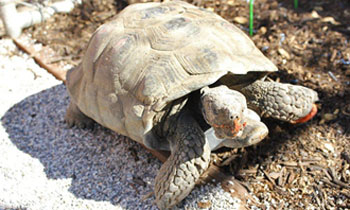
Reptiles, including this Sulcata tortoise, are no strangers to Los Angeles County animal control officers.
“You never know what people have up there,” Mayeda said. “They’re out in the middle of nowhere, they get all sorts of exotic animals and they’re zoned for it, too. A lot of the companies that provide animals for film and TV are located up there.”
Then there’s Thousand Oaks, a Ventura County community which contracts with the L.A. County Department of Animal Care and Control for services. Not only was the ordinarily quiet area the site of the Great Cobra Hunt; recently a capybara, known as the world’s largest rodent and weighing in at up to 100 pounds, turned up there as well.
There’s no designated exotic animal handler on the county staff. “Whoever catches the call, they’re going to have to figure it out or call for help,” Mayeda said. “Nobody’s ever handled a cobra before. We’ve handled plenty of rattlesnakes, but cobras are different—faster and a lot more dangerous.”
The white cobra is now safely under quarantine at the San Diego Zoo. And, in case you’re wondering, Wally the rogue camel has been relocated to a more secure facility—in Ventura County.
Posted 10/1/14
Moving forward at Descanso
June 11, 2014
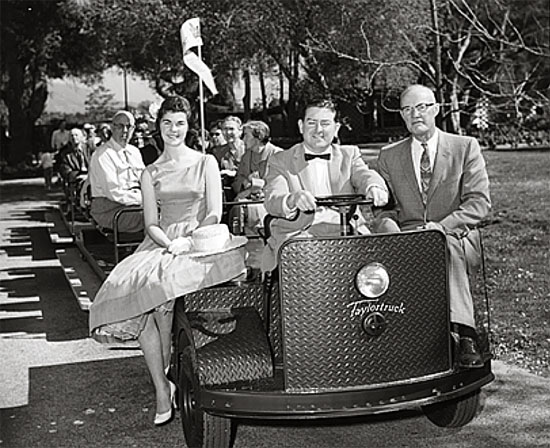
Trams have been a fixture at the gardens since the 1960s. But they've now come to the end of the road.
When an early morning fire engulfed a storage structure at Descanso Gardens in January, a bit of history went up in smoke. And maybe that wasn’t so bad, admits the garden’s executive director, David R. Brown.
Descanso’s vast botanic collection completely escaped the blaze that took firefighters about 2 hours to extinguish. But the flames devoured virtually all of the Los Angeles County facility’s tools and vehicles—including trams that had ferried visitors around the 160-acre grounds since the early 1960s.
While the trams were part of Descano’s longtime culture, they also were “very large and noisy and intrusive,” unable to deliver people to some of the garden’s most popular but secluded spots, according to Brown. That included the historic Boddy House, with a hilltop setting too challenging for many of Descanso’s elderly, disabled or simply out-of-shape visitors to reach.
In all, Brown said, only 8% of Decanso’s 250,000 annual visitors were boarding the trams, which would sit idle on busy weekends because they were too unwieldy for the garden’s crowded walkways.
In visitor surveys, Brown said, “mobility came up over and over and over again, that it’s not comfortable to walk here.” The fire, he said, “allowed us to rethink the notion of a superior visitor experience.”
Among other upcoming changes, Brown said, the trams will be replaced by electric-powered shuttles—essentially big golf carts—that will transport as many as six passengers into regions previously accessible only by foot. The shuttles will be free and compliant with the Americans with Disabilities Act—unlike the $4-a-ride trams.
The timing, Brown said, couldn’t be better. In the months ahead, Descanso will open a 5-acre exhibit in a previously-closed section of the gardens. Promotional materials say the undertaking will replicate and honor the region’s native landscape of oak woodlands, meadows and chaparral—an ecosystem that has been increasingly threatened by aggressive development. The new shuttles, he said, are key in helping the Oak Woodland Project find its audience.
“We wanted to give people access to the further reaches of the gardens,” Brown said, “so they can have a physical experience with a landscape that typified Southern California before it was explored and developed.”
Descanso gardens has long been considered one of Southern California’s premiere public gardens, perhaps best known for its thousands of towering camellias and expansive rose garden. Located in affluent La Canada Flintridge, in the shadow of the San Gabriel Mountains, Descano was founded by E. Manchester Boddy, the former publisher of the Los Angeles Daily News. He sold the property—including his 22-room mansion—to Los Angeles County in 1953.
Brown, the former president of Art Center College of Design, was named executive director of Descanso in 2005 by the Board of Supervisors.
Beyond the trams, he said other vehicles and equipment destroyed in the fire also will be replaced with more efficient, environmentally-friendly versions through insurance, county funding and foundation grants.
Still, everything post-fire isn’t coming up roses—or camellias, as the case may be. Damage from the fire, which apparently was sparked by an electrical problem, has been estimated to be as high as $750,000. And some of the items reduced to ash were priceless—including two old refrigerated boxcars owned by Boddy.
“Mythology holds that Mr. Boddy once used them to ship his camellias to customers in the Midwest and on the East Coast,” Brown said.
But overall, now that the smoke has cleared, the opportunities are clear.
“In a way, the fire was sort of a cleansing experience,” Brown said. “It kind of pulled us together.”
Posted 6/11/14
Here comes the rain
February 26, 2014
The good news is that the rain has finally arrived.
Unfortunately, in some parts of Southern California, that threatens to be the bad news too.
Parched by drought and charred by wildfires, Los Angeles County has spent the week both cheering and dreading the Pacific storm systems that are predicted to soak California—and perhaps Sunday’s Academy Awards—with the wettest weather L.A. has seen since 2012.
“On one hand, the region is in sore need of drought relief, so we’re happy to have it,” says Kerjon Lee, county Department of Public Works spokesman. “But the hillsides around the Colby Fire, the Madison Fire, the Powerhouse Fire, even the Station Fire—those areas haven’t recovered.
“The hills no longer have vegetation or trees or shrubs to prevent erosion. And the upper crust of the soil has been scorched, so it’s less absorbent. Water runs across it as if it had a wax surface.”
In other words, don’t just grab an umbrella, L.A. County. Get ready for mudslides, too.
At the Department of Public Works, the situation is all-hands and the mission is twofold—first, to make sure in this drought that every possible drop of rainfall is captured, and, second, to protect local homeowners and businesses from a potential onslaught of coursing storm water and debris.
“We try not to be alarmist, but the threat right below the burn area of the Colby Fire in the foothills above Glendora is pretty serious,” Lee says.
To that end, he says, the department has been partnering not just with Glendora but with cities throughout the foothill burn areas of the San Gabriel Valley. So far, DPW engineers have advised some 700 county homeowners and businesses on ways to protect their property in the event of rain.
Public Works crews also have been working since last year with state and local agencies, the U.S. Geological Survey and others to assess risk, clean out debris basins and install crib dam structures at strategic locations in burn sites.
Drought notwithstanding, the storm preparations have been intensive. In the area of last May’s Powerhouse Fire alone, for instance, the county has installed nearly a mile’s worth of concrete barricades, or k-rail, along Walkatop, Munz Ranch, San Francisquito Canyon and Elizabeth Lake roads, plus metal standpipes at more than a dozen locations and more than 2,100 feet of embankment protection, all during the last eight months.
That’s not counting the routine storm preparations the department does every year in the county’s massive flood control system, which includes 14 major dams, 487 miles of open channels and 2,919 miles of storm drains. Or the prep work done by Los Angeles city sanitation crews, whose jobs have included clearing the catch basins near Hollywood’s Dolby Theatre, where the red carpet for Sunday’s Oscars is already out (and covered in rainproof plastic).
Nor does it include longer-term projects like La Canada’s Mullally debris basin, which was expanded in late 2010 after winter storms the prior year clogged its drainage system. (Debris from the 2009 Station Fire had been brought down by the rainstorms, and the backup had inundated nearby homeowners with a wall of mud.)
While DPW crews try to prevent storm water from inundating local roadways, county “storm boss” Michele Chimienti , who heads dam operations for the department’s water resources branch, will be trying to save as much of it as possible.
This week’s storms, heavy as they may end up being, won’t reverse the drought that has dogged California for the past three years; in fact, the overall lack of precipitation has been such a concern that this week, the Board of Supervisors extended the county’s lease on its two Super Scooper fire-fighting aircraft.
But one function of the county dams is to gather water that can be released periodically to replenish the underground aquifers that, in turn, generate about a third of the region’s drinking water.
Right now, Lee says, most of those dams are at less than 5% capacity, so there’s plenty of room for more.
While the county battens down the hatches of its infrastructure, homeowners can make their own storm preparations.
Appearing before the Board of Supervisors this week, Public Works Director Gail Farber reminded the public that the county’s Coordinated Agency Recovery Effort web site will be updated as the storm progresses with information on road conditions, flooding, forecasts, emergency contacts, disaster preparedness and assistance programs. (For details, click here.)
The Los Angeles County Sheriff’s Department suggests that, if you haven’t already, you should sign up for free public safety alerts from the department via Nixle. They also are offering tips on storm-proofing your vehicle—and your driving habits.
DPW also has this handy list of places to obtain free sandbags and this free guide to flash flood preparedness. For homeowners interested in rain barrels, the City of Los Angeles offers this guide to rainwater harvesting.
And one more bit of advice from the experts: Don’t forget to turn off your sprinklers. With any luck, the upside of this storm will carry over onto your water bill.
Posted 2/26/14
Heroes in hardhats
January 8, 2014
They have rescued small children from oncoming traffic. They have brought a victim of attempted murder back from the brink of death. They have braved rising floodwaters and raging house fires. Last month, they dragged an unconscious driver from a burning SUV seconds before the truck’s gas tank exploded.
Not all first responders are sheriff’s deputies or firefighters. Some also find themselves in the occasional life-and-death situation while minding the county’s infrastructure at the Department of Public Works.
Emergency response has been among DPW’s core services since 1985 when the department was created, though the public tends to be more familiar with the department’s work in engineering, flood control and road maintenance. DPW maintains a 24-hour emergency operations center, and employees there are trained for disaster.
In fact, over the years, so many DPW hardhats have stepped into the breach so often that after a beloved employee named Kelly Bolor died in Iraq in 2003 while serving as a member of the U.S. Army Reserves in Mosul, the department created an in-house award for valor that has been presented in the wake of a number of incidents.
Since that date, nearly two dozen DPW employees have received the Kelly Bolor Award for heroism of one sort or another, from Ignacio Orozco Jr., who used a county dump truck to head off a potentially fatal car crash on Imperial Highway last year to members of Road Maintenance Division Crew 551, who extinguished a raging house fire in 2011 near their Antelope Valley work site, to Gary Clinton, who used his motorgrader to rescue panicked motorists from a flooded crossing in the high desert in 2005.
“I’ve been with the county for 29 years, and I think we’ve all at one time or another been first responders in some kind of situation,” says Steven Smith, a road maintenance superintendent in Agoura whose crew members, Lowell Johanknecht and Enrique Ramos, are expected to be nominated this year for pulling a woman from a burning SUV on Mulholland Highway on September 18.
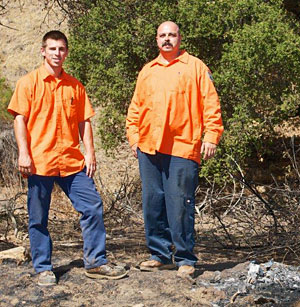
Lowell Johanknecht, left, and Enrique Ramos are the latest Public Works heroes. Photo/ Christian Garcia DPW
“If an accident happens and you’re around, you rise to the occasion. This job can be dangerous, too.”
That certainly was the case for the award’s first recipient, Marco Andonaegui, who was replacing traffic signs in 2004 on Topanga Canyon Boulevard near the 101
Freeway when he glanced up and saw a child tumble out of an SUV.
“He was 8 years old and his buckle must have come undone,” says Andonaegui, a 30-year DPW employee who says he still gets chills when he thinks of how close the child came to being hit by oncoming traffic.
“I was alone, going the opposite direction and they were just a couple a cars in front of me.”
Andonaegui scrambled out of his county vehicle, jumped the median and grabbed the child as the SUV drove on, the child’s mother oblivious to what had happened.
“Cars were swerving around us, braking around us, the little boy was crying and crying,” recalls Andonaegui. “I don’t know how the heck I didn’t get hit, let alone the little kid.”
Fifteen minutes later, he says, the mother circled back, frantic.
“She was desperate and grateful, and she must have given me 20 or 30 thank yous, but she was crying so hard, she forgot to ask for my name or give me hers,” he remembers.
It was only afterward, he says, that he learned she had written down the phone number on the back of his county truck and called the department. A father of grown children, he says he never heard from the woman again and still doesn’t know her name or her son’s name, but he still keeps his award plaque in his Lynwood living room.
Dam Operator Gary Elrod says he and his fellow crewmen on the remote San Gabriel Dam compound likewise never heard again from the young man they rescued.
It was early on a Tuesday morning, May 29, 2007, and the seven dam workers, several of whom live on the isolated site high in the San Gabriel Mountains, were starting their day early when Assistant Dam Operator Benny Velasco spotted a body in a drain near the roadside.
“It looked like he’d been attacked at another location, stuffed in the trunk of his car, driven to the entrance area of the San Gabriel Dam in Azusa Canyon and left there for dead,” recalls Elrod. “I personally counted nine stab wounds.”
A 25-year DPW employee who had worked in his youth with an emergency response team in Saudi Arabia, Elrod says he grabbed his blanket and safety gear and started to administer first aid.
As the crew waited for paramedics to arrive, Elrod tried to keep the barely coherent victim from falling into unconsciousness.
“This isn’t your time,” he remembers repeating to the young man as the sun rose over the mountains. In the hospital, Elrod says, the victim, who was from Whittier, refused to name his attacker, and the case was still unsolved three months later when he stopped asking about it.
“He denied everything he’d said to me when the sheriff questioned him later,” says Elrod. “All I know is, he’s out there somewhere with a horror story to tell his children and he’s lucky we came along when we did.”
The workers say they don’t mind that the recipients of their help often have no idea who they are or what department they work for.
“It makes you feel good just to be able to help,” says Johanknecht, the 23-year-old road laborer who pulled the woman from the burning truck last month on Mulholland Highway near Las Virgenes Road.
Johanknecht, who lives in Redondo Beach, says he had finished his shift at the Road Maintenance Division’s Yard 339 near Agoura Hills and was heading off to meet his girlfriend at their community college when he noticed the plume of smoke and the overturned Chevrolet Suburban. Pulling over on his motorcycle, he called 911 and ran toward the crash site.
“The 911 operator asked if anyone was in the car, and I said yeah, there’s a lady in the driver’s seat,” he remembers. “Right then, an older gentleman on a bicycle came up the hill and said, ‘What do you want to do?’ And I said, ‘Get her out!’”
Just then, he says, Ramos pulled over, having seen the skid marks, the smoke and his coworker’s abandoned Suzuki DR650. Working together, the three wrestled the woman, who appeared to be in her 40s, out of the black SUV and back toward the road’s shoulder.
“She was panicked and freaking out and pushing us away and in shock,” Johanknecht says, “and smoke was engulfing the car and all the air bags had deployed and blocked all the windows.”
As they carried the woman to safety, the SUV’s gas tank exploded, igniting a brushfire that engulfed nearly two acres before two Super Scoopers and four water-dropping helicopters were called in to contain it. Los Angeles County Fire Inspector Scott Miller could not release the woman’s name, but said she was transported to a local hospital. Ramos and Johanknecht say they never found out who she was and haven’t heard from her.
Johanknecht says his parents and girlfriend were “worried and proud at the same time” when they heard what happened, and wishes the crash victim—whoever she is—a speedy recovery.
“You never expect this, but you never know—we work out here in no man’s land, and a lot of things happen,” he says. “I just hope that someone would do me the same favor if something like that ever happens to me.”
Posted 10/15/13
A loss as big as all outdoors
October 17, 2013
Some people spend their lives trying to move mountains. Dave Brown was more ambitious: He devoted his life to ensuring that the mountains remain unchanged.
Brown, an historian, environmental activist and college professor who died Saturday at the age of 79 at his home in Calabasas, was remembered this week as a lifelong civic voice for the coastal trails, streams, hills and canyons in the wilderness area where he lived since 1966.
“His soul was devoted to the Central Santa Monica Mountains and the part of the Simi Hills that touches the Santa Monica Mountains,” said Paul Edelman, deputy director of natural resources and planning at the Santa Monica Mountains Conservancy, where Brown had served as a member of the advisory board since the mid-1980s.
“He was just this guardian and watchdog who would go to incredible lengths to make sure they were protected, and who cared about every major piece.”
Brown, who was born in Illinois and moved to California as a graduate student in the late 1950s, taught history and political science for more than 40 years at Los Angeles Valley College in Van Nuys, but was also known locally for his passionate efforts, starting in the 1970s and early 1980s, to halt development in the pristine mountains.
Working determinedly within the local environmental movement, Brown contributed to the preservation of tens of thousands of acres. He was one of a number of local influencers who helped stop the development of King Gillette Ranch, which had been slated to become part of a Soka University expansion; now the ranch hosts the Visitor’s Center of the Santa Monica Mountains National Recreation Area. His advocacy also helped save or create such important wilderness landmarks as Malibu Creek State Park, the Zev Yaroslavsky Las Virgenes Highlands Park and the Backbone Trail.
Over time, he became sought after as an informed and pragmatic voice on local land use issues, and he served on the city of Calabasas’ Planning Commission for several decades, winning national recognition for his civic contributions. He also devoted countless hours to the Sierra Club, the Audubon Society, the Malibu Creek State Park Docents and other environmental organizations. (To catch a moment of a Brown-led tour of the park several years ago, click here.)
“He was an incredible, encyclopedic resource,” said Kim Lamorie, who knew him as a 35-year member of the Las Virgenes Homeowners Federation, of which Lamorie is president.
“He knew all the properties, he knew all the trees, he knew every ridgeline. And he was a master mapper. He had more maps than anyone I’ve ever known.”
“He was a big man with a big hat and a big voice, and he spoke with a lot of authority,” said John Suwara, a friend and neighbor of nearly four decades. “Dave was a realist, but he fought tooth and nail, right up to the end.
“Even as recently as March, he was going to Planning Commission meetings and reviewing documents. That was maybe the biggest thing about him—he did it day after day, year after year, decade after decade. He wasn’t one of these people who are there one day and gone the next.”
In fact, Edelman said, because of Brown’s longevity and commitment, there are now spots in the Santa Monica Mountains in which every visible piece of the wilderness, all the way to the horizon, is arguably there, at least in part, because of him.
“There’s one overlook on Piuma Road,” he said, “where everything you see is something he had an absolute hand in, from the valley bottom to the ridge lines.”
And then there is the matter of how the mountains shaped Brown’s life and outlook.
Last year, after the majestic, 200-acre Firehouse Hill—now the Zev Yaroslavsky Las Virgenes Highlands Park—was saved from development in Calabasas, Brown, by then in frail health, stood among its oaks and considered what the place meant to him.
“I sometimes sort of tell myself that if the Lord should see fit to send me upstairs instead of downstairs,” he said, “I would expect that I would walk up to heaven through a place like this.”
Posted 10/17/13
E-stockpile found at assessor’s office
May 3, 2012
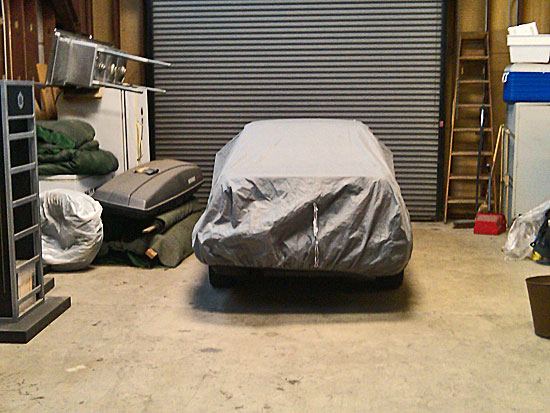
Assessor's equipment shared space in this storage facility with the landlord's car, bikes and mattresses.
As Los Angeles County was tightening its belt in recent years, its assessor’s office was sitting on a cache of more than a half-million dollars’ worth of brand-new electronics equipment it had stockpiled but never used, a newly-released county audit found.
The auditors discovered some $654,000 worth of never-used equipment, ranging from laptops to laser jet printers, languishing in storage at the Hall of Administration after it was purchased between fiscal years 2001-2 and 2009-10.
“A lot of the equipment was still brand-new, still sealed with the original vendor tape,” said David Aldava, an intermediate accountant-auditor who was part of the team that looked into technology in the assessor’s office.
Aldava’s team also made another unusual discovery: The department had improperly stashed pallets loaded with other computers, printers and tech equipment—some still functioning, some headed to the junk pile—in an unlocked, leased storage facility in Signal Hill, where the county-owned equipment shared space with the landlord’s car, bicycles, refrigerators, mattresses and even a bar sign or two.
The equipment ended up in the storage facility—next to the assessor’s South District office—after employees initially told auditors that the department had no surplus electronics. Eventually, though, the staff “told us that they had previously moved the surplus items from other locations to the storage building in an attempt to hide the equipment from us,” according to an April 13 report from Auditor-Controller Wendy Watanabe.
In a response to the audit filed last month, the department concurred with virtually all of the auditor’s 25 recommendations, most aimed at tightening accountability, record-keeping and security and ensuring that IT equipment is purchased only when needed.
Assessor’s spokesman Louis Reyes said the office is “fully cooperating” in correcting problems uncovered in the audit. “The assessor wants to address these concerns fully,” he said.
Assessor John R. Noguez was elected in November, 2010, and was not in charge during the period in which the new equipment was stockpiled, Reyes noted.
The audit comes as a separate, broader review, ordered by the Board of Supervisors, is underway to examine how the assessor’s office operates across the board. The office has come under fire for allegedly granting preferential treatment to some property owners. Noguez also shocked the supervisors recently when he disclosed a large, unprecedented disparity in property tax projections that could leave the county with a $50 million hole in its budget.
The technology audit, conducted last year and provided to the Board of Supervisors last month, offered its own set of unexpected discoveries.
“This warehouse issue really took us by surprise,” Watanabe said—especially when employees initially refused to let the auditors into the Signal Hill facility, claiming it would take a month to reach the landlord and get his permission for access. “That really piqued our interest.”
It turned out that an effort was underway, apparently, to thwart auditors from discovering an abundance of surplus equipment, which is not allowed under county policy. “They started to dump everything to Signal Hill…We finally did get in and saw stacks and stacks of used computers,” Watanabe said. “They didn’t want us to see it, to cover up that they’d initially lied.”
Even as the used computer equipment was piling up, the department was also acquiring the stacks of new and unneeded electronics—apparently part of a use-it-or-lose strategy of spending IT funds at the end of fiscal years rather than allowing unspent money to revert to the Chief Executive Office’s overall county budget, the audit found.
Beyond the cost of the equipment itself, the department overpaid by not waiting to buy the items until they were actually needed. Because technology prices tend to decrease over time, the assessor’s office ended up paying at least $93,000 more than it should have, the audit found.
Despite the huge build-up in excess tech equipment being stored, the assessor’s office still had plenty of electronic devices to go around, it appears. The audit found that 324 of the department’s 1,425 employees had at least two computers assigned to them—and 57 had three or more.
“To us, this is just ridiculous,” Watanabe said. “There’s really no business reason to justify why someone would have three or more computers.”
The employees themselves admitted as much to county auditors when asked about those second or third computers.
“Oh, yeah, it’s just sitting in my trunk,” some said when questioned about laptops they’d been issued, according to Watanabe.
Having an unused laptop lying around the house or car has hidden costs, too, Watanabe said, since the county pays virtual network fees of $600 a year for each employee who logs onto the network from outside the office—whether a device is being used or not.
Then there were security lapses. The audit said that the assessor’s department disposed of some surplus equipment without first erasing county information from the devices’ hard drives. It also found that 22% of the department’s computers didn’t have any working anti-virus protection.
Although Watanabe said no fraud was uncovered, the audit found a system of lax controls and a cavalier attitude toward safeguarding county property.
As for the surplus devices stashed in Signal Hill, those have all been junked or donated since the audit, or will be soon, according to the department. And employees in the assessor’s office have begun working their way through that unused stockpile of new equipment.
Posted /3/12
Free disposal day at Sunshine Canyon
April 18, 2012
If you live in the unincorporated San Fernando Valley and your garage looks like an episode of “Hoarders,” here’s a chance to dispose of bulky waste items for free. This Saturday, April 21, the Sunshine Canyon Landfill will hold a free disposal day, courtesy of Los Angeles County Supervisors Zev Yaroslavsky and Michael D. Antonovich.
To take advantage of the service, residents must live in unincorporated Sunland, Kagel Canyon, Lopez Canyon, West Chatsworth, Oat Mountain/Twin Lakes, Lake Manor or West Hills and bring proof of residency or a copy of the event flyer that was distributed by mail. Up to one ton—yes, 2,000 pounds—of household discards, including furniture, appliances and debris, will be accepted per resident.
But you don’t have to send everything to the landfill. Still useful items like functioning appliances can be donated through the Los Angeles County Materials Exchange.
Business waste and hazardous waste such as electronics, paint and cleaning products will not be accepted at this event. To find out how to properly dispose of them, visit the Department of Public Works “Clean L.A.” website or call (888) CLEANLA.
Sunshine Canyon Landfill will be open from 8 a.m. to 1 p.m. on the day of the event. The landfill is located at 14747 San Fernando Road in Sylmar. To learn about other waste services the facility provides throughout the year or to receive notification of future free disposal days, call (800) 926-0607 or email [email protected].
Posted 4/18/12
A whirlwind of trouble
December 1, 2011
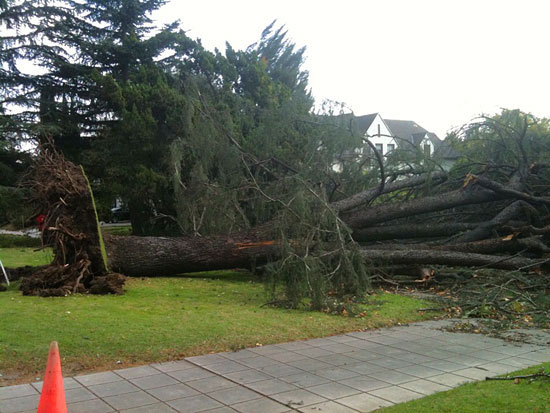
Two historic deodars were toppled in Los Feliz by windstorms. Photo courtesy of City Councilman Tom LaBonge.
For more than 75 years, majestic deodar cedars have lined Los Feliz Boulevard along Griffith Park. The imposing trees are an indelible part of the neighborhood’s character—and such a significant slice of the Los Angeles landscape that they’ve been granted cultural landmark status.
But no amount of civic protection could spare two of the beloved giants from the savage winds sweeping through the county this week. They were among hundreds of trees damaged or uprooted as gusts of wind approaching 100 miles an hour slammed Southern California, downing power lines and wreaking havoc including widespread outages, road closures and “wind days” in some local schools.
Much of the damage has been centered in San Gabriel Mountain foothill communities such as Pasadena, San Gabriel, Arcadia and Sierra Madre.
But the winds have left their mark on the Westside and the San Fernando Valley as well.
The toppled Los Feliz deodars, their massive roots completely unearthed, served as a powerful reminder of the winds’ damaging potential.
The trees, located in a stretch of some 200 deodars that together are classified as city Historical Cultural Landmark 67, were planted as part of a civic beautification movement in 1935.
The landmark designation means that they may not be pruned without official approval—but the winds did not play by the rules.
City Councilman Tom LaBonge, whose district is home to the trees, said the damage came as part of “the worst windstorm I have ever seen in the City of Los Angeles.”
“We don’t like to lose any of them,” said Donald Seligman, president of the Los Feliz Improvement Association, which maintains the trees. “They’re very unique for Los Angeles.”
With more high winds on the way, officials are urging extreme caution around power lines and trees. If you encounter a downed or dangling line, stay away from it and call 911 immediately. If you can, stay indoors, but don’t use the elevators, which could stall if there is a power outage.
To report damage to roads in unincorporated Los Angeles County, the number is 1-800-675-HELP (4357.)
More wind safety tips, from the Los Angeles City Fire Department, are here. And updated information on school closures, power outages and a recently-opened emergency shelter in Pasadena is here, along with a list of other helpful links.
Los Angeles County Supervisor Michael D. Antonovich, chair of the Board of Supervisors, declared a state of emergency in the county on Thursday afternoon, clearing the way for state and federal assistance. The cities of Pasadena, Sierra Madre and Monrovia also have declared local emergencies in the wake of the wind-borne devastation.
The urban forestry division of the city Department of Street Services was among the many agencies scrambling to stay on top of the damage Thursday morning.
“It’s pretty bad,” said chief forester George Gonzalez. “Calls are pouring in like crazy.”
Although the velocity is unusual, “wind events” typically happen three to five times a year in Los Angeles, Gonzalez said.
The ferocious Santa Ana winds are expected to continue today with gusts of up to 80 miles an hour in Southern California, the National Weather Service said. They’re part of a bigger storm that’s expected to affect the southwestern U.S. through at least Friday.
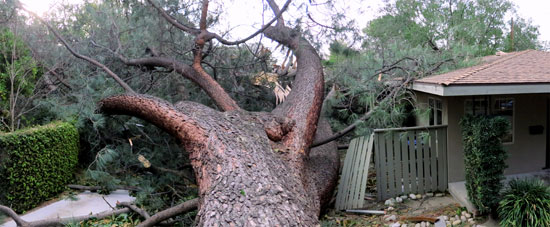
Nick Falacci took this picture of the huge tree that fell on his Pasadena house. No one was injured.
Posted 12/1/11
53 ways to survive without the 405
July 13, 2011
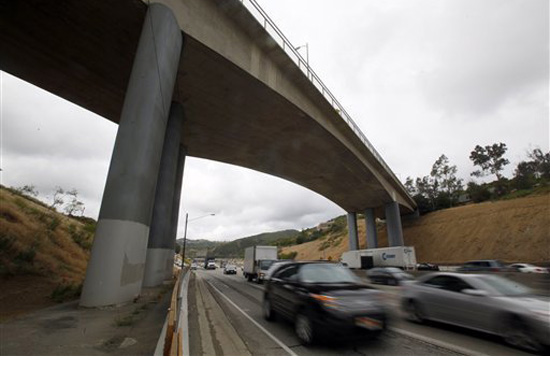
Editor’s note: These tips from the original Carmageddon could still be useful this time around. The dates have changed, of course; the 405 closure is Sept. 29-30.
In case you haven’t heard, official Los Angeles wants you to get out of town the weekend of July 15-18, or to make it a stay-close-to-home time as demolition of the Mulholland Bridge shuts down the 405 Freeway. For those of you planning to tough it out here in L.A., we asked some of our county colleagues to help us compile tips for turning 53 hours of Carmageddon fever into some good communal karma. Here’s what we came up with:
Hunkering down
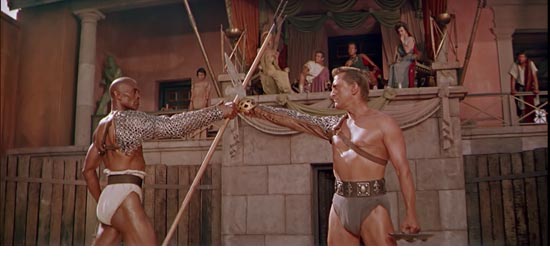
1. Honor the demise of the Mulholland Bridge by holding a mini-film festival of movies from 1960, the year it was completed. Some classic options include “Psycho” and “Spartacus.” Or see how far you can get, screening your way through AFI’s list of America’s 100 Greatest Movies.
2. Continue the mid-century theme by making a playlist that includes 1960 hits such as “It’s Now or Never” and “Only the Lonely.”
3. Adopt a pet from a local animal shelter, and spend the weekend introducing your newest family member to your home and neighborhood. Locate a nearby L.A. County shelter here; call ahead to find out whether they have animals ready for same-day adoption.
4. Dust off some old board games and hold a Clue, Scrabble or backgammon marathon. At least that little Monopoly car will still be able to zip around the board, even if the rest of Southern California is stuck in a weekend-long Sigalert.
5. Plan your next vacation(s).
6. While away a few hours perusing the Los Angeles Public Library’s digital collections of old movie posters, travel posters, fruit crate labels and photographs. (Just type in a keyword such as “Hollywood” and a year span of, say, 1959-1960, and start feasting your eyes on some amazing shots.)
7. Join Los Angeles Times architecture critic Christopher Hawthorne in his yearlong “Reading L.A.” project. The July titles include “The History of Forgetting: Los Angeles and the Erasure of Memory” and “Holy Land: A Suburban Memoir.”
8. Get an early jump on your holiday shopping without getting out of your pajamas by patronizing some of these L.A. County online stores.
9. Get organized, and do some good at the same time: Clean out your pantry and donate non-expired canned goods to a food bank. Go through closets for items to give to a charitable thrift shop. Gather up loose change and earmark the proceeds for a cause you care about.
10. Take this quiz and see if your kitchen could earn an “A” from county public health inspectors.
11. Make sure you have emergency kits in your car and at home. Check out the Department of Public Health’s emergency preparedness site for its list of 10 essential items. Update your family emergency preparedness plan and practice it. And while you’re at it, check out the county Fire Department’s fire prevention resources, too.
Building community

12. If you have a pool, invite your neighbors over for a swim and an outdoor movie.
13. Go door-to-door and collect neighbors’ phone numbers and email contacts for an emergency phone tree.
14. Organize a block party.
15. Buy a large canvas and set it on an easel in front of your house along with paints, brushes and a sign asking passersby to get artistic.
16. Enlist your neighbors in a community walking group.
17. Start a Neighborhood Watch group.
18. Drop by your local fire, police or sheriff’s station and say hello.
19. Take an interest in where your neighborhood lands in the county’s redistricting process by weighing in here. The Board of Supervisors is expected to adopt a redistricting plan by August, 2011.
20. Make a list of 10 people you haven’t spoken to in a long time and call them to say hello. Better yet, surprise each of them with a handwritten letter.
21. Check in on a sick or elderly neighbor and offer your services in the yard, kitchen or laundry room, or as an errand-runner for the afternoon. A ride to religious services might be appreciated, too.
22. Form a neighborhood group to ride in the new northbound 405 carpool lane that will stretch from the 10 to the 101 when the Sepulveda Pass project wraps up in 2013…and share the gain that comes after the pain.
Out and about

23. Be the first on your block to experience the Natural History Museum’s spectacular new Dinosaur Hall, which opens July 16. Public transportation options are probably best; find them here.
24. Frolic in a local park. Los Angeles County has more than 150 of them, so pack your Frisbee and a picnic and enjoy the summertime weather with your family. More information about park locations and amenities is here.
25. Get a library card. Or, if you already have one, make it a point to drop by over the weekend and learn about opportunities for volunteering or donating.
26. Get a group together for a Metrolink daytrip. San Juan Capistrano, anyone? Check out the station map here for other possible destinations.
27. Plug your address into www.walkscore.com and find out how walkable your neighborhood is. Then start hoofing it.
28. Patronize locally-owned businesses. (Many will show up, along with other amenities such as parks, on Walk Score, above.)
29. Take a hike. Trail systems in Los Angeles range from easy strolls to challenging hillsides. Find one that’s close to you.
30. Hit the links at a county golf course. Skip the cart rental and enjoy the walk.
31. Stock up on healthy fruits and vegetables at your local farmers market.
32. Grab your camera and head out in search of your neighborhood’s most distinctive features, from lampposts and architecture to flowerbeds and wildlife. Share your photos on Supervisor Yaroslavsky’s website.
33. Whether your taste in entertainment runs more to “Shrek The Musical” at the Pantages or Sarah McLachlan at the Hollywood Bowl or “Les Misérables” at the Ahmanson, there’s a way to get there by public transportation. And this is just the weekend to give it a try.
Make it a green weekend

34. Tear out your lawn and replace it with native plants.
35. Plant a tree. Or outsource the work to TreePeople, in honor of someone you love.
36. Start a garden. The benefits—fresh air, exercise—will go well beyond the tasty vegetables and herbs you’ll harvest. Tips are here.
37. If you’ve already got a garden, host a garden party (fancy hats optional) and send everybody home with a cutting.
38. Organize or join a produce-sharing cooperative on your block…and start off by pooling backyard lemons and making a giant batch of lemonade for everyone to share.
39. Start a backyard compost pile. (Read up first on all the benefits here.)
40. Get in line for some green by signing up your house for Energy Upgrade California at www.lacountyenergyprogram.org
41. Calculate your home’s solar energy potential.
42. Grab your reusable shopping bags and flaunt them everywhere you shop in honor of the county’s new plastic bag ban.
43. If you live near the beach, or can get there on the bus, take to the sand and help clean it up. For a list of more organized clean-up activities, look here.
44. Find out how and where to get rid of used motor oil or old computers and other “e-waste.”
45. Install some eco- and design-friendly rainbarrels to store rainwater from your roof for future use. (More information starts on Page 27 of this county manual.)
Go car-free for a day—or forever
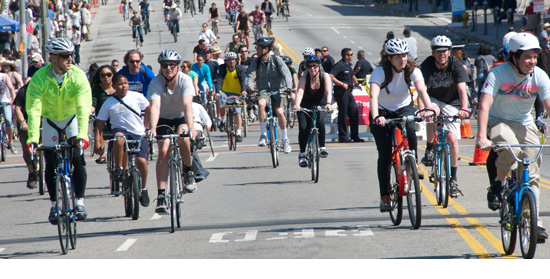
46. Ride the subway for free all weekend long. Update: There are no free rides for Carmageddon II.
47. Explore a wealth of summer destinations on public transportation.
48. While you’re riding, check out the art. Or really save energy and check out Metro’s art virtually.
49. Go out to eat without guzzling gas. The possibilities range from pastrami to rice porridge on Metro’s Dining Map.
50. Help plan and promote the next car-free CicLAvia.
51. Look up the bike trail that’s nearest to your house, and give it a try. Detailed path maps are here.
52. Get a pedestrian’s eye view of L.A. history by following one of these self-guided Angel’s Walk itineraries. Other downtown walks are here.
53. Practice riding your bike to work …and then when Monday rolls around, really do it. And congratulations, you made it through 53 hours without the 405 Freeway!
Posted 6/15/11




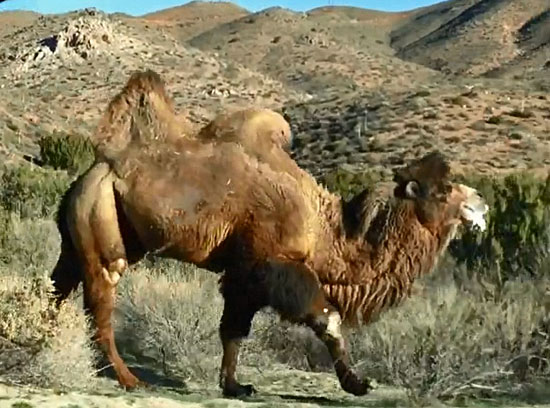

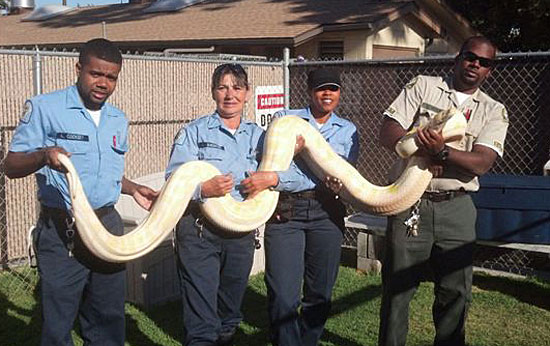
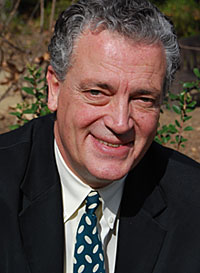
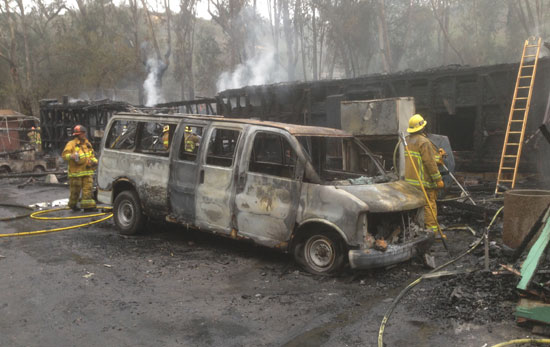
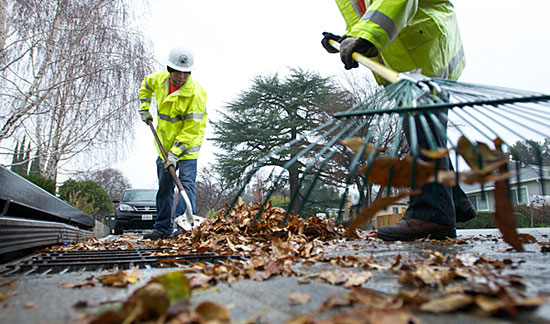
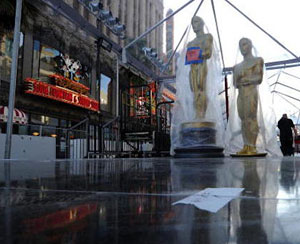
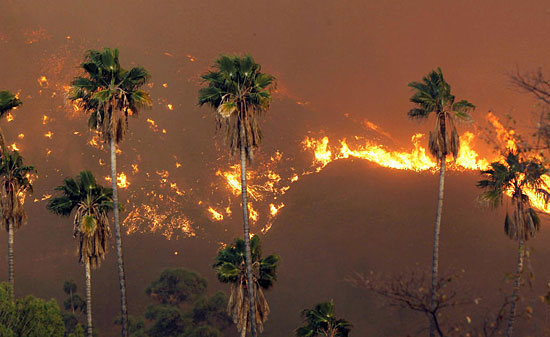
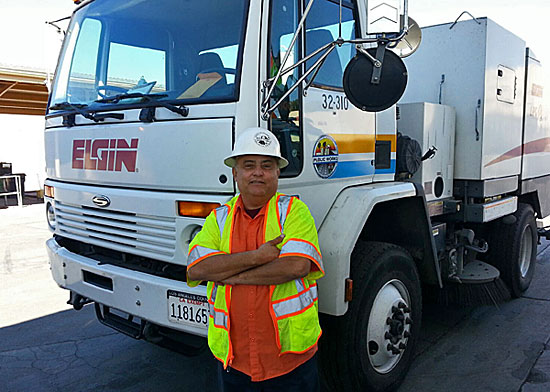
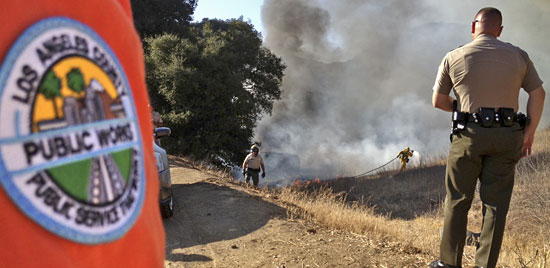

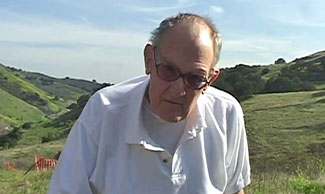
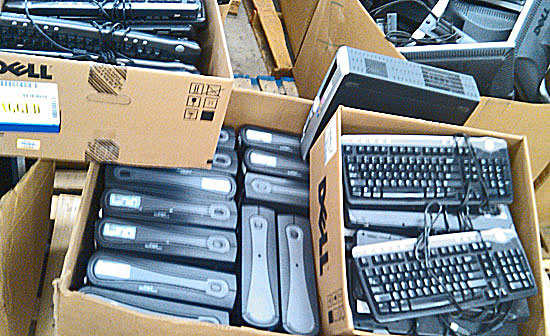
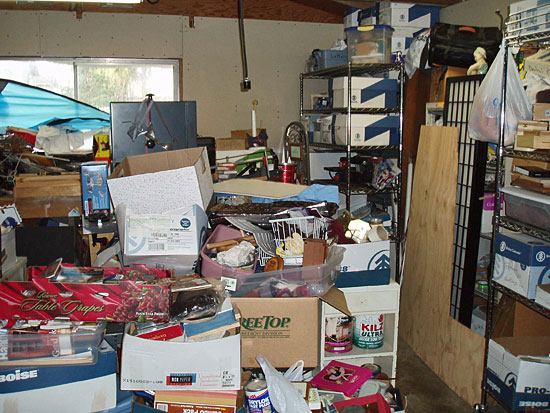
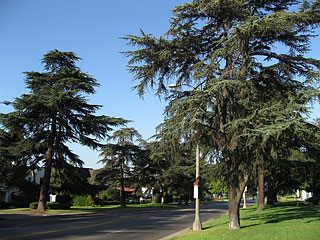







 405 bridge work causes a stink
405 bridge work causes a stink

